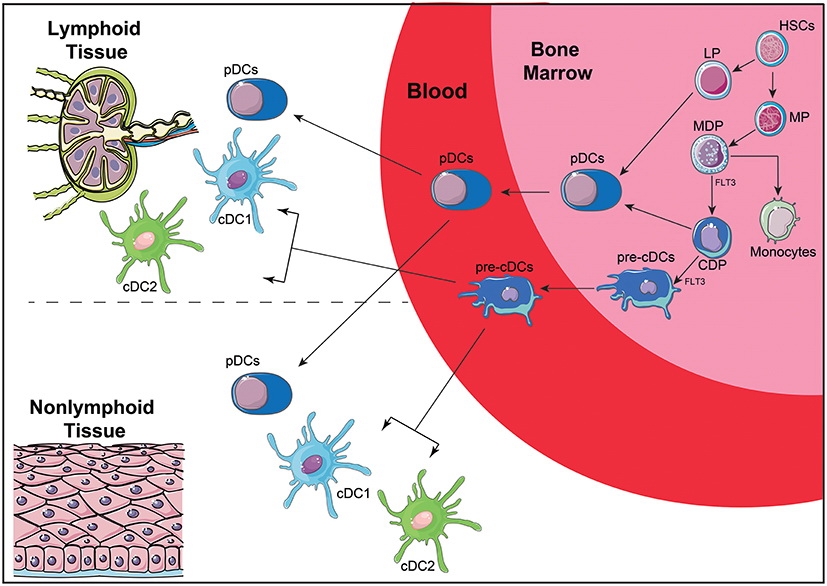Dendritic Cell
Available Resources for the Study of Dendritic Cell
- At Creative BioMart, we understand the significance of dendritic cell research and aim to provide researchers with high-quality products and resources to advance their studies in this field. Our range of products includes recombinant proteins and others, which are essential tools for understanding the function and mechanisms of dendritic cells.
- Our team of experts consists of individuals with extensive knowledge and expertise in dendritic cell research. They are committed to delivering personalized solutions to meet the specific requirements of each researcher.
- In addition to our products, we offer a comprehensive collection of resources to further support your research on dendritic cells. Our resources include detailed information on the involved pathways, protein functions, interacting proteins, relevant research articles, and other valuable information. These resources aim to provide researchers with a holistic understanding of dendritic cell biology and enhance their research outcomes.
About Dendritic Cell
Dendritic cells (DCs) are a specialized type of immune cell that plays a crucial role in the immune system's ability to recognize and respond to pathogens. They are named for their distinctive branched projections called dendrites, which give them a tree-like appearance. DCs are key antigen-presenting cells (APCs) that bridge the innate and adaptive immune responses. They act as sentinels, constantly surveying their surroundings for foreign antigens, such as pathogens or cancer cells. Once they capture antigens, they process and present them to other immune cells, particularly T cells, initiating adaptive immune responses.
Dendritic cells have unique morphological features that distinguish them from other immune cells. They possess numerous long, branching extensions called dendrites, which extend from the cell body. These dendrites increase the cell's surface area, facilitating antigen capture and interactions with other immune cells. Dendritic cells also have a round or elongated cell body with a large nucleus and prominent nucleoli.
Dendritic cells originate from hematopoietic stem cells in the bone marrow. The process of dendritic cell development involves several stages. Common myeloid progenitors (CMPs) give rise to common dendritic cell progenitors (CDPs). CDPs then differentiate into two main subsets: conventional dendritic cells (cDCs) and plasmacytoid dendritic cells (pDCs). The differentiation of cDCs further involves distinct intermediate stages, resulting in different subsets of cDCs with specialized functions in immune responses.
CDs can be divided into conventional dendritic cells (cDC) and plasmacytoid dendritic cells (pDC).
- Conventional Dendritic Cells (cDCs)
- cDC1: These DCs express specific surface markers, such as CD8 and XCR1, and are specialized in the cross-presentation of antigens on MHC class I molecules. They play a crucial role in activating CD8+ cytotoxic T cells.
- cDC2: These DCs express CD11c and CD11b markers and are involved in antigen presentation to CD4+ helper T cells. They are responsible for initiating immune responses against extracellular pathogens.
- Plasmacytoid Dendritic Cells (pDCs)
- pDCs are characterized by the expression of specific markers like CD123 and CD303 (BDCA-2). They are known for their ability to produce large amounts of type I interferons in response to viral infections, contributing to antiviral immune responses.
It's important to note that dendritic cell subsets can exhibit phenotypic and functional heterogeneity depending on the tissue or microenvironment in which they reside.
In summary, dendritic cells are specialized immune cells with unique morphological features and functions. They play a crucial role in antigen capture, processing, and presentation to other immune cells, initiating adaptive immune responses. Dendritic cells encompass different subsets, including cDCs and pDCs, each with distinct marker expression and specialized functions in immune regulation and defense against pathogens.
 Fig.1 Simplified scheme of DC ontogeny. (Patente TA, et al., 2019)
Fig.1 Simplified scheme of DC ontogeny. (Patente TA, et al., 2019)
DC arise from HSC that give rise to MP and LP. MP are further differentiated into MDP that can differentiate into CDP and monocytes. CDP differentiate further into pDC or pre-cDC. LP can also give rise to pDC, although this ontogenic pathway is not completely elucidated. Once in the blood, pre-cDC give rise to two of the main DC subtypes: cDC1 and cDC2. Both pDC and cDC can migrate from the blood to lymphoid and non-lymphoid tissues. HSC, hematopoietic stem cell; MP, myeloid precursors; LP, lymphoid precursors; MDP, macrophage-DC precursors; CDP, common DC precursors; pre-cDC, pre-classical dendritic cells; pDC, plasmacytoid dendritic cells; cDCs, conventional dendritic cells; FLT3, Fms-Related Tyrosine Kinase 3.
The Relationship Between Dendritic Cells and Immune Diseases
Dendritic cells (DCs) play a significant role in immune diseases as they are key regulators of immune responses. Dysregulation or malfunctioning of DCs can contribute to the development and progression of various immune-mediated disorders. Here are some examples of the relationship between dendritic cells and immune diseases:
- Autoimmune Diseases: Autoimmune diseases occur when the immune system mistakenly attacks and damages the body's own tissues. DCs are involved in the breakdown of immune tolerance, a key factor in autoimmune diseases. Dysregulated DCs can present self-antigens to autoreactive T cells, leading to the activation of these T cells and subsequent autoimmune responses. DCs also contribute to the imbalance between pro-inflammatory and regulatory responses, promoting chronic inflammation seen in autoimmune diseases such as rheumatoid arthritis, systemic lupus erythematosus (SLE), and multiple sclerosis (MS).
- Allergic Diseases: Allergic diseases, including asthma, allergic rhinitis, and atopic dermatitis, result from exaggerated immune responses to harmless substances (allergens). DCs play a critical role in the initiation and regulation of allergic immune responses. They capture allergens and present them to T cells, leading to the activation of allergen-specific immune responses. Dysregulated DC function can contribute to the skewing of immune responses towards an allergic phenotype, leading to the production of allergic mediators, such as IgE antibodies and pro-inflammatory cytokines.
- Cancer: Dendritic cells play a crucial role in anti-tumor immune responses. They capture tumor antigens and present them to T cells, activating tumor-specific immune responses. However, in the tumor microenvironment, DCs can become dysfunctional and exhibit impaired antigen presentation and immune activation. This can lead to immune evasion by tumor cells and the promotion of tumor growth. Strategies to enhance DC function and antigen presentation are being explored in cancer immunotherapy to boost anti-tumor immune responses.
- Infectious Diseases: DCs act as the first line of defense against pathogens by capturing and presenting antigens to initiate immune responses. However, pathogens have developed various strategies to evade or manipulate DC function, which can impair effective immune responses. For example, certain viruses can infect and disrupt DCs, leading to impaired antigen presentation and compromised immune responses. Understanding the interplay between pathogens and DCs is critical for the development of effective strategies to combat infectious diseases.
- Graft-Versus-Host Disease (GVHD): GVHD occurs after allogeneic hematopoietic stem cell transplantation, where donor immune cells attack the recipient's tissues. DCs play a crucial role in the initiation and regulation of GVHD. They present donor antigens to recipient T cells, initiating the alloreactive immune responses. Dysregulated DC function can contribute to excessive T cell activation and the development of GVHD.
Overall, dendritic cells have a significant impact on immune diseases. Their role in antigen presentation, immune regulation, and immune tolerance makes them important targets for therapeutic interventions aimed at modulating immune responses in various immune-mediated disorders. Understanding the intricate relationship between dendritic cells and immune diseases provides insights into disease mechanisms and potential avenues for developing novel treatments and immunotherapies.
Our Advantages

If you have any questions, requirements, or cooperation intentions, please feel free to contact us. We very much look forward to working with you and helping you achieve research and commercial success.
References:
- Liu K. Dendritic Cells. Encyclopedia of Cell Biology. 2016;741-749. doi:10.1016/B978-0-12-394447-4.30111-0
- Patente TA, Pinho MP, Oliveira AA, Evangelista GCM, Bergami-Santos PC, Barbuto JAM. Human Dendritic Cells: Their Heterogeneity and Clinical Application Potential in Cancer Immunotherapy. Front Immunol. 2019;9:3176. Published 2019 Jan 21. doi:10.3389/fimmu.2018.03176


